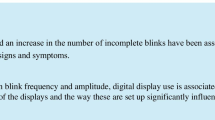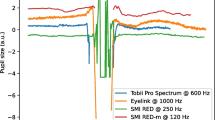Abstract
Purpose
The objective of this study was to analyze the differences in blinking kinematics of spontaneous and voluntary blinks using for the first time a self-developed, non-invasive, and image processing–based method.
Methods
The blinks of 30 subjects were recorded for 1 min with the support of an eye-tracking device based on a high-speed infrared video camera, working at 250 frames per second, under two different experimental conditions. For the first condition, subjects were ordered to look in the straightforward position at a fixation target placed 1 m in front of them, with no further instructions. For the second, subjects were additionally asked to blink only following a sound signal every 6 s.
Results
Mean complete blinks increased by a factor of 1.7 from the spontaneous to the voluntary condition while mean incomplete blinks reduced significantly by a factor of 0.4. In both conditions, closing mean and peak velocities were always significantly greater and durations significantly lower than opening ones. When comparing the values for each condition, velocities and amplitudes for the voluntary condition were always greater than the corresponding values for spontaneous.
Conclusion
Voluntary blinks revealed significant kinematic differences compared to spontaneous, thus supporting a different supranuclear pathway organization. This study presents a new method, based on image analysis, for the non-invasive kinematic characterization of blinking.







Similar content being viewed by others
References
McMonnies CW (2007) Incomplete blinking: exposure keratopathy, lid wiper epitheliopathy, dry eye, refractive surgery, and dry contact lenses. Cont Lens Anterior Eye 31:37–51
Kaneko K, Sakamoto K (1999) Evaluation of three types of blinks with the use of electro-oculogram and electromyogram. Percept Mot Skills 88:1037–1052
Robinson DA (1963) A method of measuring eye movement using a scleral search coil in a magnetic field. IEEE Trans Biomed Eng 10:137–145
Jie Y, Sella R, Feng J, Gomez ML, Afshari NA (2019) Evaluation of incomplete blinking as a measurement of dry eye disease. Ocul Surf 17:440–446
Cochener B, Cassan A, Omiel L (2018) Prevalence of meibomian gland dysfunction at the time of cataract surgery. J Cataract Refract Surg 44:144–148
Choi SH, Park KS, Sung MW, Kim KH (2003) Dynamic and quantitative evaluation of eyelid motion using image analysis. Med Biol Eng Comput 41:146–150
Kwon KA, Shipley RJ, Edirisinghe M, Ezra DG, Rose G, Best SM, Cameron RE (2013) High-speed camera characterization of voluntary eye blinking kinematics. J R Soc Interface 10:20130227
Perez J, Espinosa J, Domenech B, Mas D, Illueca C (2011) Blinking kinematics description through non-invasive measurement. J Mod Opt 58:1857–1863
Kimura N, Watanabe A, Suzuki K, Toyoda H, Hakamata N, Fukuoka H, Washimi Y, Arahata Y, Takeda A, Kondo M, Mizuno T, Kinoshita S (2017) Measurement of spontaneous blinks in patients with Parkinson’s disease using a new high-speed blink analysis system. J Neurol Sci 380:200–204
Schiffman RM, Christianson MD, Jacobsen G, Hirsch JD, Reis BL (2000) Reliability and validity of the Ocular Surface Disease Index. Arch Ophthalmol 118:615–621
Agostino R, Bologna M, Dinapoli L, Gregori B, Fabbrini G, Accornero N, Baradelli A (2008) Voluntary, spontaneous, and reflex blinking in Parkinson’s disease. Mov Disord 23:669–675
Bologna M, Agostino R, Gregori B, Belvisi D, Ottaviani D, Colosimo C, Fabbrini G, Berardelli A (2009) Voluntary, spontaneous and reflex Blinking in patients with clinically probable progressive supranuclear palsy. Brain 132:502–510
Deuschl G, Goddemeier C (1998) Spontaneous and reflex activity of facial muscles in dystonia, Parkinson’s disease, and in normal subjects. J Neurol Neurosurg Psychiatry 64:320–324
Efron N (2012) Part II Eyelids. Blinking abnormalities. In: Efron N (ed) Contact lens complications, 3rd edn. Elsevier/Saunders, London, pp 39–46
Doughty MJ (2001) Consideration of three types of spontaneous eyeblink activity in normal humans: during reading and video display terminal use, in primary gaze, and while in conversation. Optom Vis Sci 78:712–725
Zaman ML, Doughty MJ (1997) Some methodological issues in the assessment of the spontaneous eyeblink frequency in man. Ophthalmic Physiol Opt 17:421–432
Bahill AT, Clark MR, Stark L (1975) The main sequence, a tool for studying human eye movements. Math Biosci 24:191–204
Cruz AA, Garcia DM, Pinto CT, Cechetti SP (2011) Spontaneous eyeblink activity. Ocul Surf 9:29–41
Evinger C, Manning KA, Sibony PA (1991) Eyelid movements. Mechanisms and normal data. Invest Ophthalmol Vis Sci 32:387–400
Ponder E, Kennedy WP (1928) On the act of blinking. Quart J Exp Physiol 18:89–110
Naase T, Doughty MJ, Button NF (2005) An assessment of the pattern of spontaneous eyeblink activity under the influence of topical anaesthesia. Graefes Arch Clin Exp Ophthalmol 243:306–312
Espinosa J, Domenech B, Vázquez C, Pérez J, Mas D (2018) Blinking characterization from high speed video records. Application to biometric authentication. PLoS One 13:e0196125
Malbouisson JM, Messias A, Garcia DM, Cechetti Sde P, Barbosa JC, Cruz AA (2010) Modeling upper eyelid kinematics during spontaneous and reflex blinks. J Neurosci Methods 191:119–125
Sforza C, Rango M, Galante D, Bresolin N, Ferrario VF (2008) Spontaneous blinking in healthy persons: an optoelectronic study of eyelid motion. Ophthalmic Physiol Opt 28:345–353
Baker RS, Abou-Jaoude ES, Napier SH (2005) Kinematic comparison of spontaneously generated blinks and voluntary blinks in normal adult subjects. AJCS 22:35–39
Garcia DM, Messias A, Costa LO, Pinto CT, Barbosa JC, Cruz AA (2010) Spontaneous blinking in patients with Graves’ upper eyelid retraction. Curr Eye Res 35:459–465
Sun WS, Barker RS, Chuke JC, Rouholiman BR, Hasan SA, Gaza W, Stava MW, Porter JD (1997) Age-related changes in human blinks. Passive and active changes in eyelid kinematics. Invest Ophthalmol Vis Sci 38:92–99
Wu Z, Begley CG, Situ P, Simpson T (2014) The effects of increasing ocular surface stimulation on blinking and sensation. Invest Ophthalmol Vis Sci 55:1555–1563
Korosec M, Zidar I, Reits D, Evinger C, Vanderwerf F (2006) Eyelid movements during blinking in patients with Parkinson’s disease. Mov Disord 21:1248–1251
Funding
This research was supported in part by a “Formación de Profesorado Universitario” Scholarship (FPU17/03665, Ministerio de Educación, Cultura y Deporte) awarded to Cristian Talens Estarelles, by the Spanish Government through the MINECO research project DPI2017-89867-C2-2-R, and by the research project GV/2018/059, from “Conselleria d’Educació, Investigació, Cultura i Esport de la Generalitat Valenciana,” awarded to Santiago García Lázaro.
Author information
Authors and Affiliations
Corresponding author
Ethics declarations
Conflict of interest
The authors declare that they have no conflict of interest.
Ethics approval
All procedures performed in studies involving human participants were in accordance with the ethical standards of the institutional and/or national research committee (Ethical Committee of the University of Valencia) and with the 1964 Helsinki declaration and its later amendments or comparable ethical standards.
Informed consent
Informed consent was obtained from all individual participants included in the study.
Additional information
Publisher’s note
Springer Nature remains neutral with regard to jurisdictional claims in published maps and institutional affiliations.
Rights and permissions
About this article
Cite this article
Sanchis-Jurado, V., Talens-Estarelles, C., Esteve-Taboada, J.J. et al. Non-invasive high-speed blinking kinematics characterization. Graefes Arch Clin Exp Ophthalmol 258, 2701–2714 (2020). https://doi.org/10.1007/s00417-020-04782-w
Received:
Revised:
Accepted:
Published:
Issue Date:
DOI: https://doi.org/10.1007/s00417-020-04782-w




